As an experienced camper, I know how important it is to have enough water when you’re camping. I’ve seen people struggle because they didn’t bring enough water. When you’re out in nature, water is not just for drinking—it is used for a variety of other things as well.
Figuring out how much water to bring camping can be tricky, but I’ve learned a lot from my own camping trips. I’ve camped in many different places, and I’ve found that the right amount of water depends on things like how long you’ll be camping, what activities you’ll be doing, and what the weather is like.
But don’t worry, I am going to help you figure it out how much water you need for your camping trip.
For camping in the wilderness without a water source, you will need 1 gallon of water per person per day for drinking and an additional 1 gallon for other uses like cooking, washing, and personal hygiene.
In this article, we are going to discuss the topic in detail and help you figure out how much water you need for your next camping trip. We will also discuss how to find and filter water if you ever run dry.
How Much Water per Person per Day Camping?
When I go camping, one of the first questions I ask myself is, “How much water should I bring for each person each day?” It’s a really important question because it helps make sure everyone stays healthy and happy during the trip.
After many camping adventures, I’ve learned some useful tips to help figure this out.
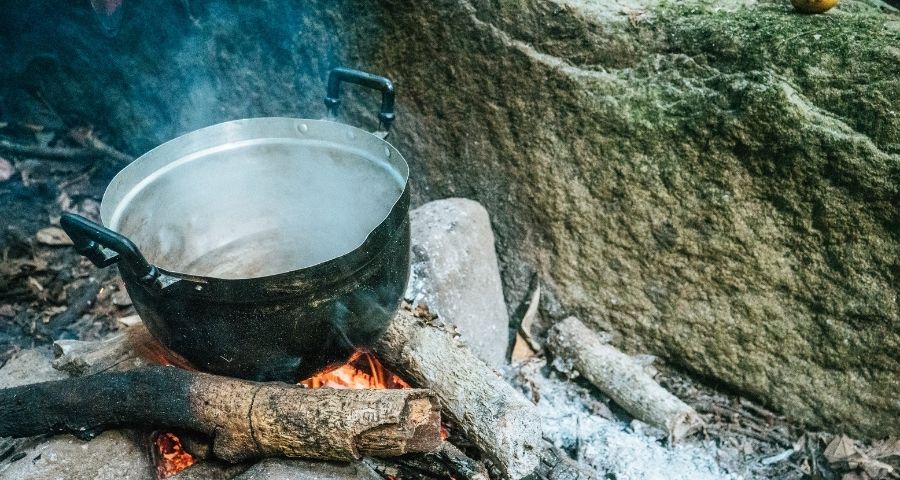
A good rule to follow is to bring at least half a gallon (64 ounces) of water per person per day for drinking. But remember, you might need more water if you’re doing a lot of activities or if it’s really hot outside.
In those cases, it’s a good idea to bring up to one gallon (128 ounces) of water per person per day.
You also need water for other things like cooking and washing. I usually bring an extra half gallon (64 ounces) per person per day for these activities. You might need more or less depending on what you’re planning to cook and how much cleaning you’ll be doing.
To make it simple, if you’re going on a 3-day camping trip with 4 people, you should bring at least 12 gallons (48 half-gallons) of water for drinking, plus an extra 6 gallons (24 half-gallons) for cooking and washing. That’s a total of 18 gallons of water for your 3-day trip.
Of course, every camping trip is different, and you might need to adjust these amounts based on your own needs and experiences. But these guidelines have helped me plan many successful camping trips, and I hope they’ll help you too!
Below table summarizes the rule of thumb I just discussed.
| Water Usage | Amount/person/day |
|---|---|
| For drinking | 64 ounces |
| For cooking | 64 ounces |
| For washing & cleaning | 72 ounces. (8 ounces for brushing, 64 ounces for personal hygiene) |
Pro Tip: While in the wilderness, if you see a freshwater source, drink to your fullest even if you are not thirsty, and also refill your water storage.
Some people also carry their pets with them while camping. You can gauge how much water your dog needs by their weight, activity level, and temperature outside. Keep extra water and use a collapsible water bowl to keep your pet hydrated.
Keep in mind the climate and conditions of your camping site as well. If you are planning to watch a sunset beside a pond and it includes no physical activity, then you don’t need to worry about your water problem.
With little or no physical or strenuous activity, less water will be consumed.
But if you are planning to camp in the wilderness or desert with a lot of physical activities, then you must be careful with the water resources.
How to save water while camping?
When I usually go camping, I try to preserve as much water as I can. This might look easy, but it requires a lot of management.
While in the wilderness, water resources are limited, and you don’t want to spend your camping time in search of water, so it’s wise to be extremely careful where you use your water stock.
Below are a few tricks and tips for preserving water while camping. These tips will help you stretch your water supply a bit further.
- Pre-cook your food at home before you leave so you can minimize cooking water.
- Use hand sanitizers instead of water for your hands (unless you have physical dirt on your hands)
- Use baby wipes or facial wipes for your personal hygiene.
- Pace yourself before any strenuous activity to control sweating.
- Use dry shampoos for your hair wash.
- Reuse cooking water to soak dirty pans.
- Use biodegradable soap for washing.
- If you find any safe or freshwater source, drink up to your fill so you can save your carrying water for later
How to Purify Water When Camping?
If you run out of water during camping and returning to the base is not an option, your next best chance is to search for a source of fresh water nearby.
You can search for a pond or river nearby. But drinking directly from these sources can put your health at risk. The water source can be contaminated with many dangerous chemicals, bacteria, viruses, and decayed remains of dead animals.
Drinking water without purification can be harmful to your health.
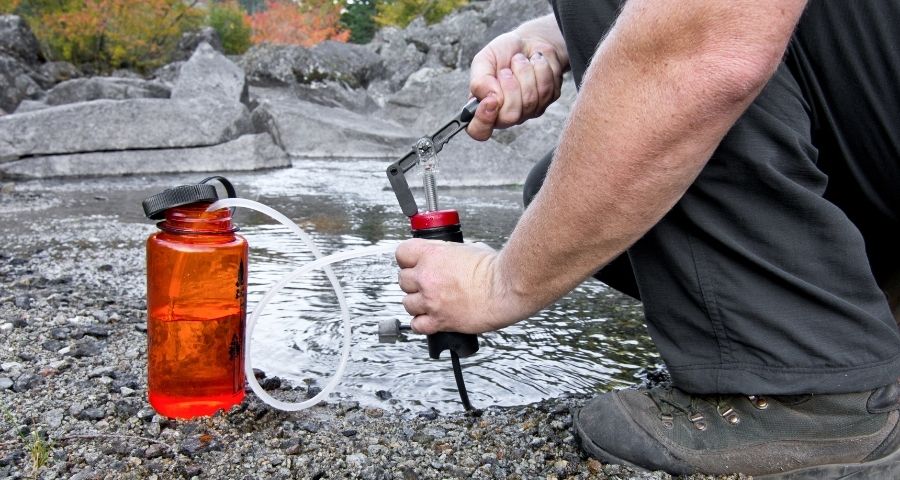
Knowing how to purify water can save you!
Few methods and techniques are very helpful in these circumstances. By using these methods, you can easily purify and use these water resources. These are very simple and easy to implement.
Boiling
It is the most effective and old method to purify water. Collect the water in a bowl and boil it on your propane tank stove or atop your campfire for at least 1 minute. The heat will kill all bacteria and pathogens.
Let the water settle and filter through a clean cloth if it is cloudy.
Distillation
Distillation is the process of vaporizing unclean water and condensing the vapors in a separate container to get clean water. This will result in the purest form of water (it will not even have the natural salts, hence will taste weird too, but it’s clean).
The distillation process also removes bacteria and most germs if done properly.
Although there are many setups that you can use to distill unclean water, the one I am going to tell is the simplest and doesn’t require any special equipment.
It might not be very effective compared to the distillation setup in your 10th-grade chemistry class it works.
To distill water this way, you will need one large pot with a lid and a smaller container/pot that fits and can float inside the large container.
- Collect unclean water in the large pot and put it on the stove or campfire.
- Put the small pot inside the larger pot so that it floats on the surface of the water (or not, depending on its weight and how much water is in the large pot.
- Take the large pot lid and place it on top of the large pot INVERTED. This is necessary to collect the vapors and condense them back to the water.
- Now when you heat the water, the water in the large pot will vaporize and when the vapors hit the inverted lid, they will condense on the surface and drip down into the smaller pot that is floating below.
- To assist the condensation, you can place something cold on the outer surface of the lid like cold mud (but make sure you don’t contaminate the clean water or even pour some of the unclean water on it.
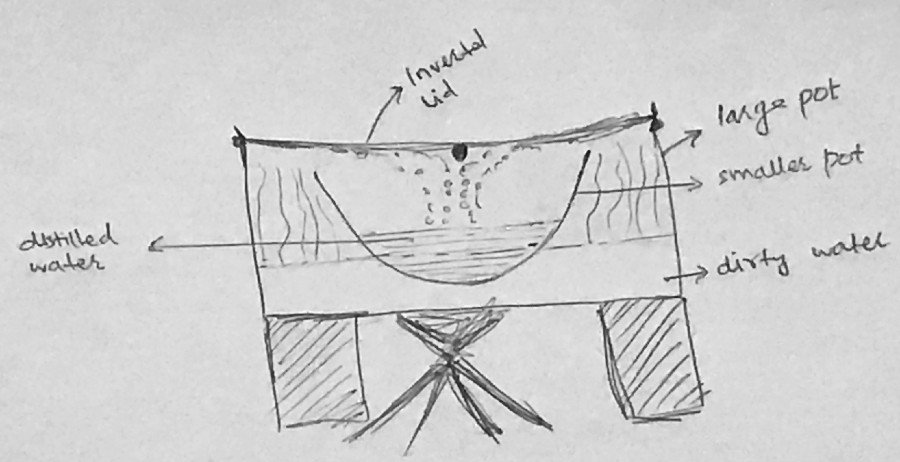
Purification Tablets
This method is the easiest of all. Add a few tablets in unclean water and wait for 3-4 hours. The tablets used are mostly iodine and chlorine dioxide-based.
My go-to tablets are the Potable Aqua (Amazon Link) which are cheap, easy to use, and don’t leave any taste after you use them.
Water Filters
Water filters are of different types. It is the best way to cut down on water weight. It enables you to drink from any source (stream, pond, etc.) instead of carrying all of your water.
You can find a lot of water filters online as well as at hardware stores near you. They all work on the same principle – pass water through a few layers of natural or artificial porous material to filter out dirt and large bacteria.
My favorite filter is this one available on Amazon or Walmart easily. It’s cheap, easy to use, and does what it is designed for.
When combined with the gravity bag (you can buy the filter with or without the gravity bag), it becomes very handy. You can leave the filter connected to the filled gravity bag and get a lot of filtered water overnight.
Even if you don’t have a filter, you can make one using two standard soft drink bottles.
- Gather two standard soft drink bottles.
- Cut the bottom off one bottle.
- Fill the cut bottle with clean sand and gravel.
- Pour water into the top cut section.
- Collect filtered water from the neck of the bottle.
Note: Less effective/slower than commercial filters, but helpful in emergencies.
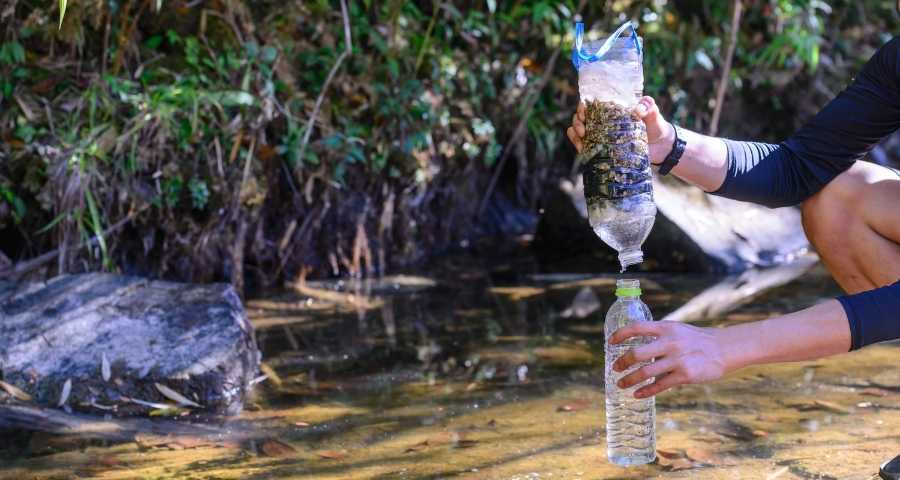
Best ways to carry water for camping
Carrying all your water on your back is not a good idea. It will be difficult to access water from time to time and you will not be able to drink plenty of it.
You have to choose something that can supply a source of water throughout, not adding much weight to carry.
Hard bottles, collapsible bottles, hydration bladders, and soda bottles all can carry water, but the question is, which one is the best way to carry water?
Water Bottles
Water bottles are easy to carry, cheap, and often disposable. Traditional hard bottles are cheap and easily available and quite handy but they take up unnecessary space when empty.
Make sure the bottle you chose is BPA-free. I would recommend getting one from Nalgene. They are inexpensive, BPA free, and quite famous among outdoorsy people.
In comparison, flexible rubber bottles can be rolled and collapsed to carry easily without taking up much of your packing space.
Again, get a BPA-free one. I would recommend HydraPak Stash in this category.
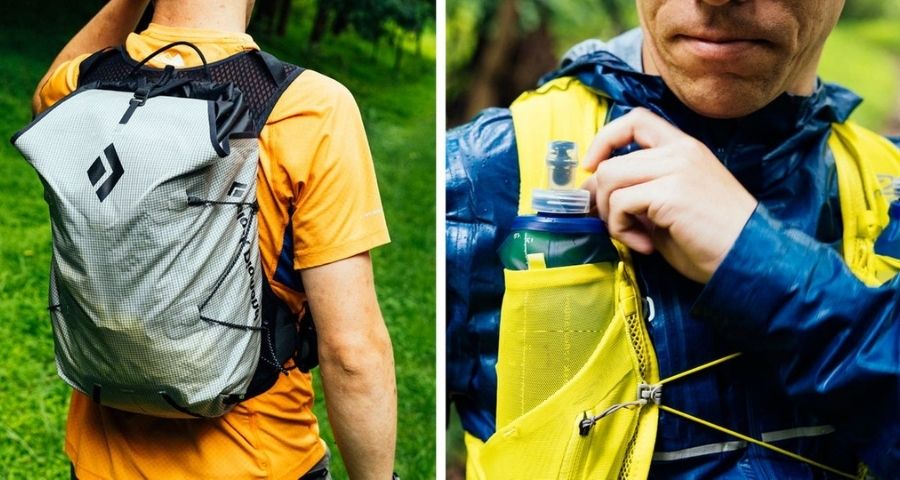
Hydration Bladders or Packs
Hydration packs are specially designed water containers that you can carry inside your backpack or even wear as a backpack.
They can carry a lot of water with ease and come with a sipping pipe that you can use to sip while going on your trail.
My go-to hydration pack is Aquamira pressurized pack [Amazon Link].
What to do if you run out of water?
Even if you take great care of your water supply during camping, you might still run out of it every now and then.
Managed campsites have a regular supply of water, so if you are near such a site, it’s not really a problem. But if you are in the wilderness away from civilization, you will have to do some serious water hunting.
Most natural habitats have a water supply in some form. You will find a river, creek, pond, or even a waterfall nearby. Following vegetation and wildlife is the best way to find such a spot.
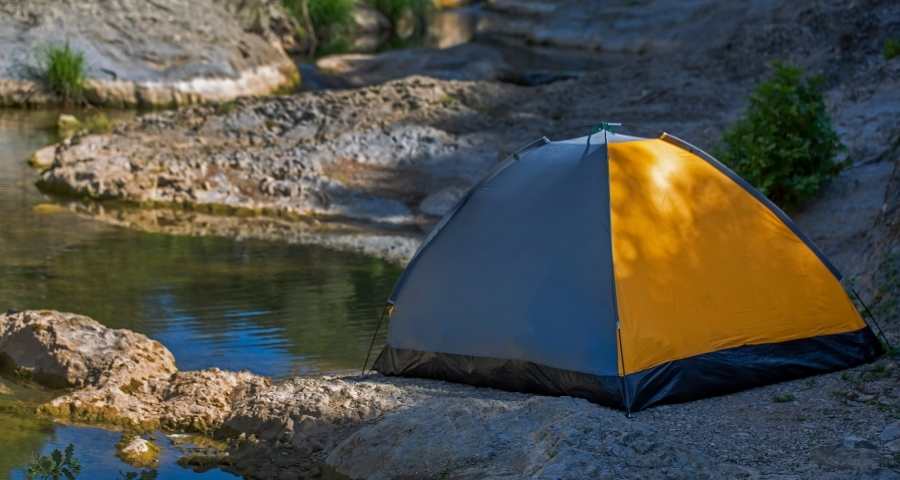
Pro Tip: Before you leave for the wilderness, familiarize yourself with the surroundings, find suitable camping spots, and mark water bodies near you in case of emergencies.
How Much Water Do I Need for Camping – Conclusion
To summarize the discussion, always carry enough water with you wherever you go for offsite camping and make sure you manage your water for the time you are away from a water source.
For drinking, you need at least 1 gallon per person per day. The climate, temperature, and activities play an important role in camping.
Explore the camping spot before going if there is any water source there to be on the safer side. Camping is all fun and adventure unless you have your resources with you. Having extra water on your side is better than no water in the middle of the wilderness.
Happy camping.
Recommended Camping Gears: I have compiled a list of my favourite camping gear in one place. The selection is based on my own personal experience using them for many years camping as well as feedback from fellow campers. Check them out on my Recommended Camping Gears page